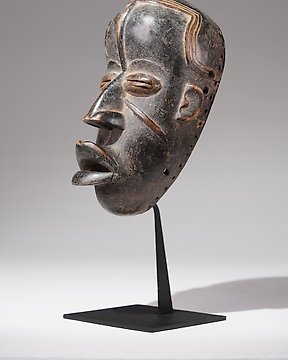
Bete - Costa do Marfim (Sem preço de reserva)
N.º 83565331

N.º 83565331

A Grebo mask, with rectangular mouth showing teeth, pointed nose elongated going through to the top of the forehead, two rows of cylindric eyes, painted in red and white pigment, allowing for an additional visual impoact; traces of use.
"As enigmatic as they are renowned, these instantly recognisable ‘cubist’ masks were attributed to the Grebo and Kru people settled in south-east Liberia and south-west Côte d’Ivoire. Long known as ‘Sassandra masks’, they were also used by the Bakwe, Godie and Neyo people, also part of the Kru language group established in the Bas-Sassandra region near Soubré, San Pedro, Fresco and Sassandra in south-western Côte d’Ivoire. Difficulties in their attribution can be explained by the analogy between the terms ‘crewmen’ and ‘Krumen’ used to refer to men of diverse origins recruited in the maritime sector - this region of the Sassandra was particularly known for its maritime trade. The term Kru also encompasses a people in their own right, a language group comprised of over thirty peoples, as well as a socio-professional category referring to men known for their navigation skills. "
"These masks, most of which disappeared in Liberia due to the ‘Grebo Wars’, represented spirits of nature or the forest as found among the We, Guere and Bete peoples, northern neighbours of the Grebo. Although used for mainly secular purposes today and for collective entertainment as among the Godie and Neyo people of Côte d’Ivoire, they were previously used, according to Alain-Michel Boyer, to “expurgate those who ate "doubles" (or souls for Christians), but that it also played a part in settling ritual conflicts between clans, in the case of a land contest, a hunting problem or the rape of a woman. With its numerous eyes, it could "watch" the fighters, but also "strengthen" them, in order to raise them above their status as men, and turn them into valiant warriors.” They are also used in funeral dances accompanied by various other animal or more figurative masks. However, for Pierre Boutin, “the information we have [on these masks] is inversely proportional to their artistic fame. Contrary to other ethnic groups in south-western Côte d’Ivoire (We, Bete, Niabwa, etc.), […] we known […] nothing of their function, - entertainment, funerary, initiatory, judicial -, of the frequency of their appearances, - regular or exceptional -, nor the audience permitted to see them - open audience, extended or limited audience, with or without restriction regarding age or gender” .
Source: Musee du quais Branly.
Fruther reading:
Boyer, Alain-Michel, Between the seen and the unseen, Paris, Sothe by’s, 12 December 2017, lot 50.
GOY Bertrand, Côte d’Ivoire : premiers regards sur la sculpture, 1850-1935, Paris, Schoffel Valluet, 2012.
Como comprar na Catawiki
1. Descubra algo especial
2. Faça a licitação vencedora
3. Faça um pagamento seguro